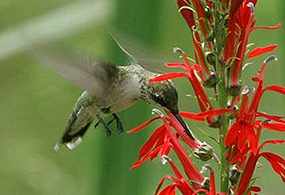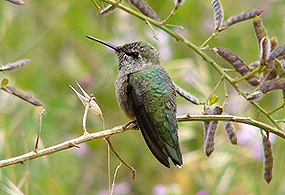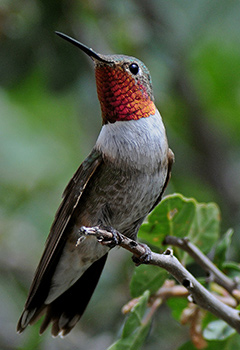Hummingbirds (family Trochilidae) are amazingly adapted pollinators, and they play an important role in pollination. They have long, slender bills and tube-like tongues that they use to drink nectar from brightly-colored flowers; this gives them the energy they need to fuel their high metabolism.
Ready to Impress

photo courtesy USFWS
In the tree-tops, a male ruby-throated hummingbird aims to impress the female sitting on a bee balm bush below. Certainly his scarlet colored gorget feathers will make her take notice. He darts around, chasing off would-be suitors from his territory, adding a shrill chirp as a warning. Then he hovers above her, dives down to her, and bolts back to the sky in a U-shaped flight during which he experiences centripetal acceleration of 10Xg forces (fighter pilots do not exceed 7Xg forces). He repeats the dance in rapid succession. Has he wooed her with his flying skills? She takes to the air with wings beating 50 times per second and visits each flower on the shrub. She drinks up the nectar for a quick burst of energy. He will have to try again.
Tiny and mighty hummingbirds

NPS
Hummingbirds (family Trochilidae) are amazingly adapted pollinators. They have long, slender bills and tube-like tongues that they use to drink nectar from brightly-colored flowers; this gives them the energy they need to fuel their high metabolism. For protein, they eat insects caught on the fly. Hummingbirds drink up to two times their body weight per day. As they move from plant to plant, they carry pollen. As they pollinate the native wildflowers in parks and the plants in your garden, hummingbirds add a splash of color to our landscapes.
Hummingbirds are only found in the western hemisphere. Most of the more than 300 species of hummers live in Central and South America. About 26 species visit the United States during part of the year and 17 breed here. In North America, ruby-throated hummingbirds populate the eastern United States; common species in the west include broad-tailed, rufus, and black-chinned.
Hummingbirds that breed in North America overwinter in Mexico, though migration corridors vary by species. Hummingbirds take epic flights that follow the coasts, the spine of the Rockies, or even across the Gulf of Mexico in a long-distance 18-to 22-hour, non-stop flight. Their migration flights to the north in the spring correspond to flowering times of native plants at their destination. Climate change may affect this synchronization.
What We Are Doing

Tena Engelman/NPS
National Parks are ideal refuges for hummingbirds because they provide large expanses of forest for breeding and nesting. Pesticide-free native plants in national parks provide excellent food sources for hummingbirds as well. Some parks—like Kenilworth Aquatic Gardens and Saint-Gaudens National Historic Site —preserve historic gardens that attract hummingbirds and other pollinators.
The National Park Service also works with scientists to track hummingbird movements and health. Licensed ornithologists capture hummingbirds and take measurements such as weight, bill length, and wing-cord length. They assess the overall health and identify the species, gender, and age of the birds. Then they place a tiny bracelet, or band, on the hummingbird’s leg. After a quick drink of sugar water, the bird is released. These data are entered in a national database. If a licensed hummingbird bander catches the bird in another location, we get information about the bird’s migration. From this research, we know that hummingbirds return to their breeding and feeding sites year after year.
See how scientists track hummingbirds by banding them at:
What You Can Do

Sally King/NPS
Hummingbirds may be found in most National Parks, so come and see hummingbirds in their native habitat. Parks in Texas, southernCalifornia, and Florida see the arrival of hummingbirds as early as February, though March through May is a prime time for watching. By early May, hummingbirds arrive in more northern latitudes such as Virginia, Tennessee, Illinois, Nebraska, and Colorado. By late May, many species of hummingbirds arrive in Maine, Minnesota, and Canada. Rufus hummingbirds fly as far north as Alaska. Find a park near you!
To attract them, you can either plant a hummingbird garden or hang a hummingbird feeder. In your garden, choose native flowers with a tube shape. Hummingbirds are not attracted by smell, so chose plants with brightly-colored flowers. To find appropriate plants in your area, you can enter your zip code for local plant information based on your ecoregion. Hummingbirds are also attracted to specialized feeders. It is very important to keep your feeder clean and use a simple sugar syrup free of honey, food coloring, or other impurities. Having a feeder does not draw the hummingbird from its natural foods, but rather gives the bird a quick burst of energy. Keep in mind, too, that larger creatures like bears and raccoons are also attracted to the sugar syrup. Cats and other hummingbird predators may also stalk your feeder. In order to protect the birds, be wise to where and what time of day you hang your feeder.
Tags
- bandelier national monument
- cabrillo national monument
- capulin volcano national monument
- chamizal national memorial
- channel islands national park
- presidio of san francisco
- rocky mountain national park
- saguaro national park
- saint-gaudens national historical park
- pollinator
- pollinators
- pollination
- hummingbird
- hummingbirds
- climate change
- fragmentation
- pesticides
- habitat loss
- nectar
Last updated: June 20, 2025
